Jul 03, 2010
A few humans make Victoria much warmer
By Andrew Bolt
Retired school principal Kenskingdom was alarmed by this Bureau of Meterology graph, showing a strong warming trend for Victoria (enlargeed here):
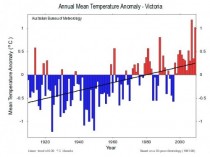
He checked the data from which the trend, and found it had first been adjusted and turned into “high quality” data. As a BOM spokesman assured him:
On the issue of adjustments you find that these have a near zero impact on the all Australian temperature because these tend to be equally positive and negative across the network (as would be expected given they are adjustments for random station changes).
Actually, no, though. You see, Kenskingdom discovered that the adjustments served to exaggerate Victoria’s warming remarkably (enlarged here)
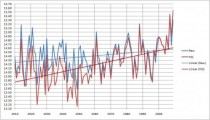
Kenskingdom goes through the individual stations for you and concludes:
There is a distinct warming trend in Victoria since the 1960s, which has been especially marked in the last 15 years.
The first half of the record shows a cooling trend. BOM’s adjustments have attempted to remove this.
2007, not 2009, was the warmest year in the past 100 years.
Three stations identified as urban in 1996 have been included.
Many stations’ data have been arbitrarily adjusted to cool earlier years
Only one station has had its trend reduced. Two are essentially unchanged.
Ten of Victoria’s 13 stations have been adjusted to increase the warming trend, to the extent that there is a warming bias of at least 133%, more likely 143%.
These adjustments, and the Australian temperature record to which they contribute, are plainly not to be trusted.
UPDATE
More climate wisdom from the Bureau of Metereology:
Melbourne has experienced its wettest June in nine years, recording 59 millimetres of rain, 10 millimetres more than the long term average…
But despite the damper conditions, the Bureau of Meteorology says there’s no end in sight to the drought.
The heavy June rain was, once again, not quite what the warmist BOM predicted back in March:
Contrasting this, the chances are between 30 and 40% for above average June quarter falls in an area encompassing much of central to southeastern SA, northwest Victoria and the far southwest corner of NSW. Across the rest (and most) of the country, the chances of exceeding the median April to June rainfall are between 40 and 60%, meaning that above average falls are about as equally likely as below average falls.
UPDATE 2
Weather is not climate, which is worth remembering when you hear the next screams of “global warming” on a hot day:
Sydney’s week of cold weather continues, with the city recording its coldest June morning since 1949 when temperatures dived to 4.3 degrees. (Thanks to reader Professor Frank.)
See Andrew’s blog post here.
Jun 30, 2010
Salazar’s Ban Is Soros’ Bonanza
IBD
Energy Policy: Our interior secretary plans to reinstate the offshore drilling moratorium struck down by a federal judge. But if deep-water drilling is so unsafe, why are we helping Brazil drill nearly three times as deep?
Maybe Secretary Ken Salazar can explain why Britain and others can safely drill in the North Sea and no other nation has suspended its offshore drilling. Yet there he was Tuesday saying he’ll reissue a reworded moratorium that will make it clear to dunces like U.S. District Judge Martin Feldman why offshore drilling is unsafe.
As with health care reform and other issues, the administration’s position is that we didn’t make it clear enough, so we will speak slower and use smaller words. But double talk is double talk no matter how you rearrange the words.
“The decision to impose a moratorium on deep-water drilling was and is the right decision,” Salazar said, even after he was caught rewording a report so a team of experts he assembled would look like they supported the moratorium, when in fact, they adamantly opposed it and thought it would do more harm than the Deepwater Horizon spill itself.
“If some drilling equipment parts are flawed, is it rational to say all are?” Feldman asked in his ruling. “Are all airplanes a danger because one was? All oil tankers like Exxon Valdez? All trains? All mines?
“That sort of thinking seems heavy-handed, and rather overbearing.” Not for an administration and its environmentalist supporters whose collective goal is not to drill safely, but to drill not at all, at least not here.
Last August, the U.S. Export-Import Bank issued a “preliminary commitment” letter to Brazil’s state-run Petrobras in the amount of $2 billion, with the promise of more to follow. Why are we lending billions to a foreign oil company that made $15 billion last year?
These taxpayer dollars finance exploration of the huge offshore discovery in Brazil’s Tupi oil field in the Santos Basin near Rio de Janeiro. Apparently there are no pristine beaches full of tourists there. Someday we may be importing that oil we’re helping Brazil get at.
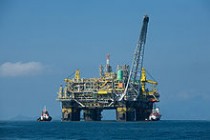
Has that letter been rescinded as part of the moratorium? Why are Brazil’s offshore fields safe but ours aren’t?
The irony is that most of the deep-water rigs idled by the moratorium may shortly be snapped up by a Petrobras apparently undeterred by images of tar balls on Rio’s beaches. Petrobras plans to drill to a depth of 14,022 feet, a depth that makes our 500-foot limit laughable. Brazil is going big-game hunting, and we’re stuck in the petting zoo.
A recent study by Science Applications International Corp. shows that failure to exploit our domestic and offshore resources translates into some $2.3 trillion in lost opportunity costs for the U.S. economy over the next two decades. The American Petroleum Institute estimates that exploiting these resources would generate nearly 160,000 well-paying jobs and $1.7 trillion in federal, state and local revenues, with $1.3 trillion from offshore drilling alone.
If the moratorium stands and energy prices rise, the only ones to profit will be foreign-owned companies such as Petrobras and investors such as George Soros, who has an investment in the oil giant in the neighborhood of $900 million. Yes, the same George Soros who also is a major investor in the Democratic Party and President Obama’s 2008 campaign.
Soros would love to see domestic offshore drilling shut down and those three dozen deep-water rigs sitting idle shipped off to the coast of Brazil. He has a huge investment in both Petrobras and the Democrats. He expects a return on all his investments.
While we track the trail of oil gushing from Deepwater Horizon, we should also follow the money that will be gushing into George Soros’ bank account, courtesy of the U.S. government and the American taxpayer. Read post here.
Jun 28, 2010
New Study: CO2 only rose after ice age ended, not before; global wind-shift to blame
By Climate Change Fraud
A global shift in winds is what led to the end of Earth’s last ice age - an event that ushered in a warmer climate and the birth of human civilization.
It is believed that, in the geological blink of an eye, ice sheets in the northern hemisphere began to collapse and warming spread quickly to the south.
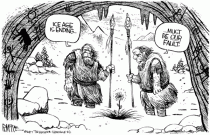
Enlarged here.
Most scientists say that the trigger, at least initially, was an orbital shift that caused more sunlight to fall across Earth’s northern half.
But they could not explain how the south dealt with the shift so fast.
And now a team of researchers looked for an answer towards a global shift in winds and proposed a chain of events that began with the melting of the large northern hemisphere ice sheets about 20,000 years ago.
The melting ice sheets reconfigured the planet’s wind belts, pushing warm air and seawater south, and pulling carbon dioxide from the deep ocean into the atmosphere, allowing the planet to heat even further.
Their hypothesis makes use of climate data preserved in cave formations, polar ice cores and deep-sea sediments to describe how Earth finally thawed out.
“This paper pulls together several recent studies to explain how warming triggered in the north moves to the south, ending an ice age,” said study co-author Bob Anderson, a geochemist at Columbia University’s Lamont-Doherty Earth Observatory.
“Finally, we have a clear picture of the global teleconnections in Earth’s climate system that are active across many time scales. These same linkages that brought the earth out of the last ice age are active today, and they will almost certainly play a role in future climate change as well,” he added.
“It’s the great global warming of all time. We’re trying to answer the puzzle: why does the Earth, when it appears so firmly in the grip of an ice age, start to warm?” said the study’s lead author, George Denton, a glaciologist at the University of Maine.
Scientists have long suspected that carbon dioxide played a major role in the last ice age but have had trouble explaining the early warming in the southern hemisphere, where glaciers in Patagonia and New Zealand were melting before carbon dioxide levels rose significantly.
Some scientists suggest that a change in ocean currents, triggered by the freshening of the North Atlantic, caused this early warming.
But computer models using ocean circulation to explain the rapid warming in the south have been unable to recreate the large temperature jumps seen in the paleoclimate record.
Now, with the evidence for shifting southern hemisphere westerlies, the rapid warming is readily explained.
The study has been published in the journal Science. See more here.
Jun 28, 2010
Amazongate: the missing evidence
By Christopher Booker
Last week the beleaguered global warming lobby was exulting over what it took to be the best news it has had in a long time. A serious allegation, which last January rocked the authority of the UN’s Intergovernmental Panel on Climate Change, was “corrected” as untrue by The Sunday Times, the newspaper which most prominently reported it. The reputation of the IPCC, it seemed, had been triumphantly vindicated. The growing tide of scepticism over climate change had at last been reversed. But this episode leaves many questions unanswered.
The “correction”, gleefully quoted by everyone from the WWF and The New York Times to The Guardian’s George Monbiot related to what was known as “Amazongate”. This was one of the series of controversies which exploded round the IPCC last winter, when it was shown that many of the high-profile claims made in its 2007 report had been based on material produced by environmental activists and campaigning groups rather than on proper, peer-reviewed scientific evidence.
2008 was the year man-made global warming was disprovedOne example, also reported in The Sunday Telegraph, was the IPCC’s much-publicised claim that climate change, leading to a reduction in rainfall, was threatening the survival of “up to 40 per cent” of the Amazon rainforest. The only source the IPCC could cite for this in its report was a document from the environmental advocacy group WWF. But last week The Sunday Times, in its prominent “correction” to its own story, conceded that the IPCC’s claim was “supported by peer-reviewed scientific evidence” after all. Not identified, however, was the nature of this peer-reviewed evidence. Where is it?
The story of “Amazon-gate” has unfolded through three stages. Step one was the passage in the IPCC report almost identical to one made in a non-peer-reviewed WWF paper of 2000 on forest fires in the Amazon. Specifically the IPCC stated that “up to 40 per cent of the Amazonian forests could react drastically to only a slight reduction in precipitation”. But the only source the WWF in turn had been able to cite to support this was a paper published in Nature in 1999, from a team led by Dr Daniel Nepstad, formerly employed by the WWF but now the “senior scientist” with another advocacy group closely linked to the WWF, the Woods Hole Research Center. Certainly Nepstad’s paper was peer-reviewed: however its subject was not climate change but the impact on the Amazon rainforest of “logging and fire”. It found that “logging companies in Amazonia kill or damage 10-40 per cent of the living biomass of forests”. This had nothing whatever to do with global warming but was cited as the origin of that “up to 40 per cent” figure later used by the WWF and the IPCC.
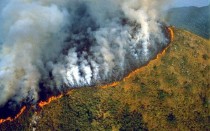
Step two, when all this was reported last January, was a disclaimer from the WWF, emphasising that its 2000 report did “not say that 40 per cent of the Amazon forest is at risk from climate change”. But it went on to say that the real source for its 2000 paper (which had been “mistakenly omitted") was another paper, “Fire in the Amazon”. This was also written by Dr Nepstad, as head of yet another advocacy group linked to Woods Hole, the Amazon Environmental Research Institute. Although it was now being suggested that this paper should have been cited as the original source for the IPCC’s claim, it too was not peer-reviewed. Thus, twice over, the IPCC’s claim appears to rest both on non-peer-reviewed science and on studies not related to global warming at all.
So great was the IPCC’s embarrassment over these revelations that the story moved to a third stage. Various scientists, led by Dr Nepstad, suggested further studies which might justify the claim. But an exhaustive trawl through all the scientific literature on this subject by my colleague Dr Richard North (who was responsible for uncovering “Amazongate” in the first place), has been unable to find a single study which confirms the specific claim made by the IPCC’s 2007 report. If one exists we would very much like to see it.
There are several studies based on computer models which attempt to estimate the possible impact of climate change on the Amazon rainforest, but none of these have so far supported that 40 per cent figure. Other researchers in turn have been highly critical of these models, suggesting that they are too crude to replicate the complex workings of the Amazonian climate system and that all observed evidence indicates that the forest is much more resilient to climate fluctuations than the alarmists would have us believe.
Nothing did more to excite attention over the effect of climate change on the rainforest than the exceptional drought of 2005, just when the IPCC’s 2007 report was being compiled. Since then, however, abnormally heavy rainfall in the region has brought disastrous floods to Brazil, both last year and again last week.
In other words there is a real mystery here. Nothing so far made public seems to justify an assertion that the IPCC’s specific claim is “supported by peer-reviewed scientific evidence”. In view of all the controversy this issue has aroused over several months, it might seem odd that, if such evidence exists, it hasn’t been produced before. Is it not now a matter of considerable public interest that we should be told what it is? See story here.
Another fine piece can be found here.
Research (below, enlarged here) shows the Amazon has benefited from increased CO2 even as deforestation took place (source CO2 Science).

Deforestation of the Amazon has been decreasing (below, enlarged here) .

Though the animal kingdom is being affected (below, enlarged here).

See also Amazongate, the Smoking Gun here.
Jun 27, 2010
BP, Greenpeace and the Big Oil Jackpot
By Jeff Blue (Dennis Quaid), Undercover Blues
In what passes for debate about climate change one of the most tiresome allegations is that skeptics are lavishly funded by big oil. As a result of this funding, so the argument goes, the public has been confused by those who’ll say anything in exchange for a paycheck.
“Follow the money” we’re told and you’ll discover that climate skeptics are irredeemably tainted. Ergo nothing they say can be trusted. Ergo their concerns, questions, and objections should be dismissed out of hand.
It’s therefore amusing that the current oil spill in the Gulf of Mexico is now drawing attention to the close relationship between climate change activists and BP - aka British Petroleum, an entity for which the descriptor “big oil” was surely invented.
According to the Washington Post the green group Nature Conservancy - which encourages ordinary citizens to personally pledge to fight climate change - “has accepted nearly $10 million in cash and land contributions from BP and affiliated corporations over the years.”
Gee, didn’t Greenpeace build an entire ExxonSecrets website to expose the allegedly diabolical fact that, over a 9-year-period (1998-2006) ExxonMobil donated a grand total of $2.2 million to a conservative think tank?
$10 million versus $2 million. Who do we suppose has the cozier relationship with big oil?
But that’s just the beginning. The Washington Post also points out that Conservation International, another green group which insists climate change represents a “profound threat,” has “accepted $2 million in donations from BP over the years and partnered with the company on a number of projects.”
Funny, Greenpeace doesn’t talk about that. Nor does it mention:
- that BP is funding research into “ways of tackling the world’s climate problem” at Princeton University to the tune of $2 million per year for 15 years
- that BP is funding an energy research institute involving two other US universities to the tune of $500 million - the aim of which is “to develop new sources of energy and reduce the impact of energy consumption on the environment”
- that ExxonMobil itself has donated $100 million to Stanford university so that researchers there can find “ways to meet growing energy needs without worsening global warming”
- The only dollar amounts Greenpeace cites in its explanation of why it decided to launch ExxonSecrets is that measly $2.2 million. Versus 10 + 2 + 30 + 500 + 100. Let’s see, which all adds up to...wait for it...$642 million.
If the world is divided into two factions - one that believes climate change is a serious problem and another that thinks human influence on the climate is so minimal it’s indistinguishable from background noise - one group has pulled off a bank heist while the other has been panhandling in front of the liquor store.
In the same document in which Greenpeace talks about the ExxonMobil money it chillingly asserts that climate “deniers” aren’t entitled to free speech. Why? Because “Freedom of speech does not apply to misinformation and propaganda.”
Actually, the big thinkers on the subject have consistently taken the opposite view. John Stuart Mill was adamant that no one has the right to decide what is or is not propaganda on everyone else’s behalf. He would have looked Greenpeace in the eye and told it to stop imagining that its own judgment is infallible.
More than a hundred years later Noam Chomsky famously declared that if you don’t believe in freedom of expression for opinions you despise you don’t believe in it at all.
If Greenpeace would like to have a serious conversation about who, exactly, is spreading misinformation I’m up for that - since it’s overwhelming obvious that the big oil jackpot was awarded to those on the Greenpeace side of the debate.
The fact that climate change activists have enjoyed such a powerful funding advantage and yet insisted all the while that the exact opposite was the case is troubling. It tells us a good deal about their intellectual rigour. About their character. And about their ability to distinguish fact from fiction.
If there really is a climate crisis, if our grandchildren’s future really is imperiled, these aren’t the people to lead us out of the wilderness.
Jeff Blue (Dennis Quaid), Undercover Blues
UPDATE (June 6): Reader Terry Kesteloot alerted me to the fact that the Greenpeace.org website is apparently infected with a “very low” risk computer virus. The links in this post to Greenpeace’s ExxonSecrets FAQ have therefore been replaced with links to a copy of the document that resides at Archive.org (scroll down once the page loads). If your machine has virus protection, the document may be viewed directly on the Greenpeace website.
ICECAP note: BP also granted $500,000 to the University of California Berkeley to study energy and the environment. That may be included in the above mention of grants to two universities. We should note BP donated nearly $1 million to the Obama Presidential campaign and was a finalist in a ‘safety award’ about to be given by the Obama administration to an oil company. Read about any of these in the old lamestream media?
|










